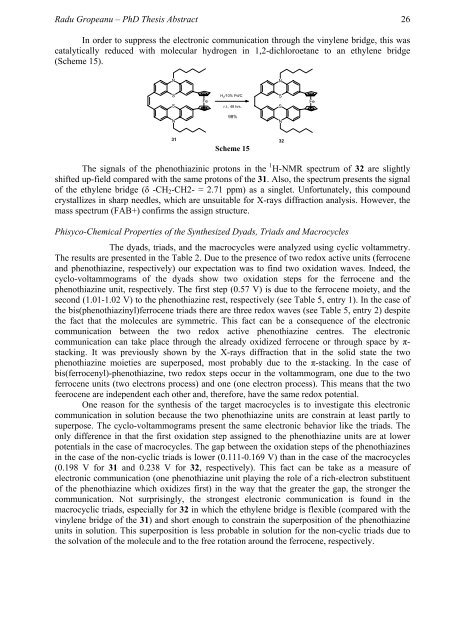Ph.D. THESIS ABSTRACT SYNTHESIS, STEREOCHEMISTRY AND ...
Ph.D. THESIS ABSTRACT SYNTHESIS, STEREOCHEMISTRY AND ...
Ph.D. THESIS ABSTRACT SYNTHESIS, STEREOCHEMISTRY AND ...
You also want an ePaper? Increase the reach of your titles
YUMPU automatically turns print PDFs into web optimized ePapers that Google loves.
Radu Gropeanu – <strong>Ph</strong>D Thesis Abstract<br />
In order to suppress the electronic communication through the vinylene bridge, this was<br />
catalytically reduced with molecular hydrogen in 1,2-dichloroetane to an ethylene bridge<br />
(Scheme 15).<br />
N<br />
S<br />
S<br />
N<br />
Fe<br />
H 2 /10% Pd/C<br />
r.t., 48 hrs.<br />
98%<br />
31 32<br />
Scheme 15<br />
The signals of the phenothiazinic protons in the 1 H-NMR spectrum of 32 are slightly<br />
shifted up-field compared with the same protons of the 31. Also, the spectrum presents the signal<br />
of the ethylene bridge (δ -CH2-CH2- = 2.71 ppm) as a singlet. Unfortunately, this compound<br />
crystallizes in sharp needles, which are unsuitable for X-rays diffraction analysis. However, the<br />
mass spectrum (FAB+) confirms the assign structure.<br />
<strong>Ph</strong>isyco-Chemical Properties of the Synthesized Dyads, Triads and Macrocycles<br />
The dyads, triads, and the macrocycles were analyzed using cyclic voltammetry.<br />
The results are presented in the Table 2. Due to the presence of two redox active units (ferrocene<br />
and phenothiazine, respectively) our expectation was to find two oxidation waves. Indeed, the<br />
cyclo-voltammograms of the dyads show two oxidation steps for the ferrocene and the<br />
phenothiazine unit, respectively. The first step (0.57 V) is due to the ferrocene moiety, and the<br />
second (1.01-1.02 V) to the phenothiazine rest, respectively (see Table 5, entry 1). In the case of<br />
the bis(phenothiazinyl)ferrocene triads there are three redox waves (see Table 5, entry 2) despite<br />
the fact that the molecules are symmetric. This fact can be a consequence of the electronic<br />
communication between the two redox active phenothiazine centres. The electronic<br />
communication can take place through the already oxidized ferrocene or through space by πstacking.<br />
It was previously shown by the X-rays diffraction that in the solid state the two<br />
phenothiazine moieties are superposed, most probably due to the π-stacking. In the case of<br />
bis(ferrocenyl)-phenothiazine, two redox steps occur in the voltammogram, one due to the two<br />
ferrocene units (two electrons process) and one (one electron process). This means that the two<br />
feerocene are independent each other and, therefore, have the same redox potential.<br />
One reason for the synthesis of the target macrocycles is to investigate this electronic<br />
communication in solution because the two phenothiazine units are constrain at least partly to<br />
superpose. The cyclo-voltammograms present the same electronic behavior like the triads. The<br />
only difference in that the first oxidation step assigned to the phenothiazine units are at lower<br />
potentials in the case of macrocycles. The gap between the oxidation steps of the phenothiazines<br />
in the case of the non-cyclic triads is lower (0.111-0.169 V) than in the case of the macrocycles<br />
(0.198 V for 31 and 0.238 V for 32, respectively). This fact can be take as a measure of<br />
electronic communication (one phenothiazine unit playing the role of a rich-electron substituent<br />
of the phenothiazine which oxidizes first) in the way that the greater the gap, the stronger the<br />
communication. Not surprisingly, the strongest electronic communication is found in the<br />
macrocyclic triads, especially for 32 in which the ethylene bridge is flexible (compared with the<br />
vinylene bridge of the 31) and short enough to constrain the superposition of the phenothiazine<br />
units in solution. This superposition is less probable in solution for the non-cyclic triads due to<br />
the solvation of the molecule and to the free rotation around the ferrocene, respectively.<br />
N<br />
S<br />
S<br />
N<br />
Fe<br />
26

















